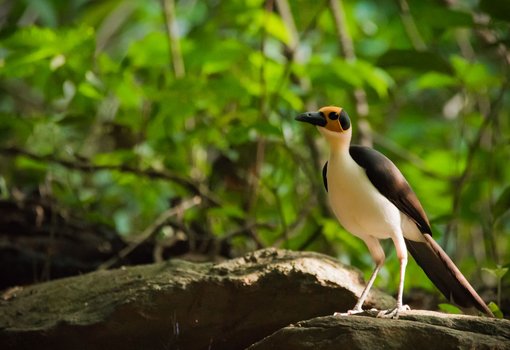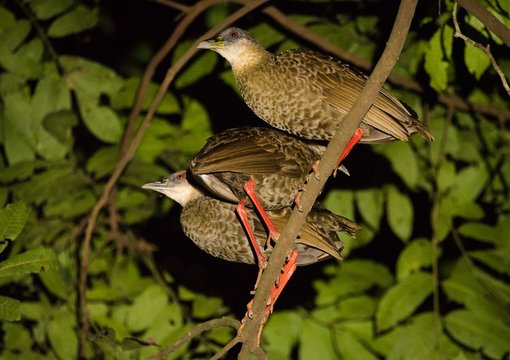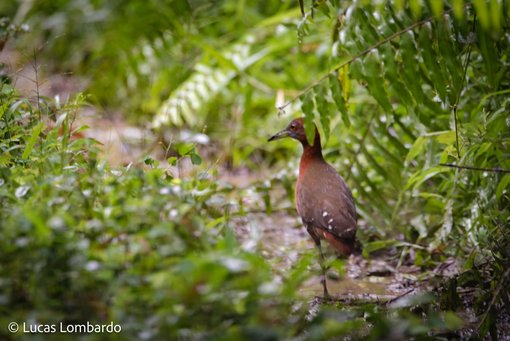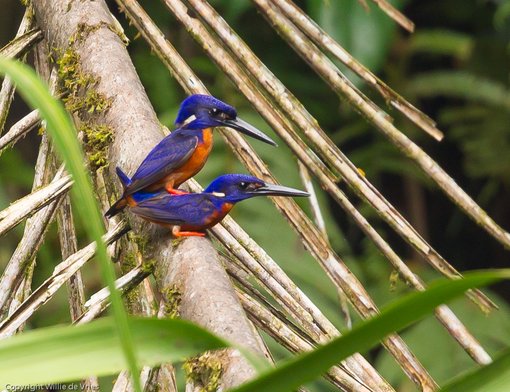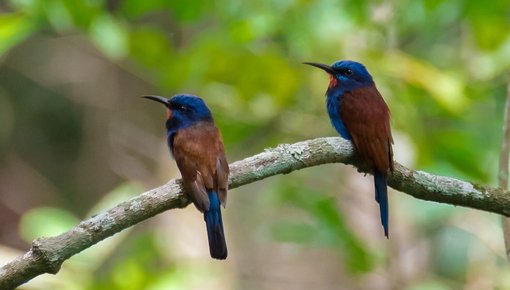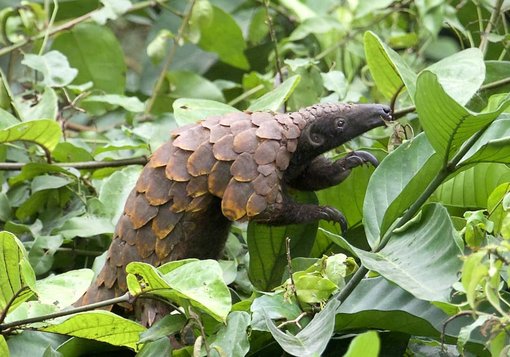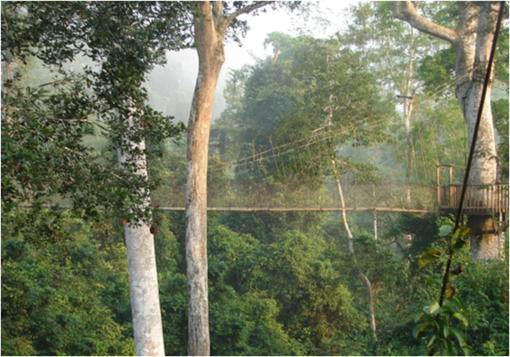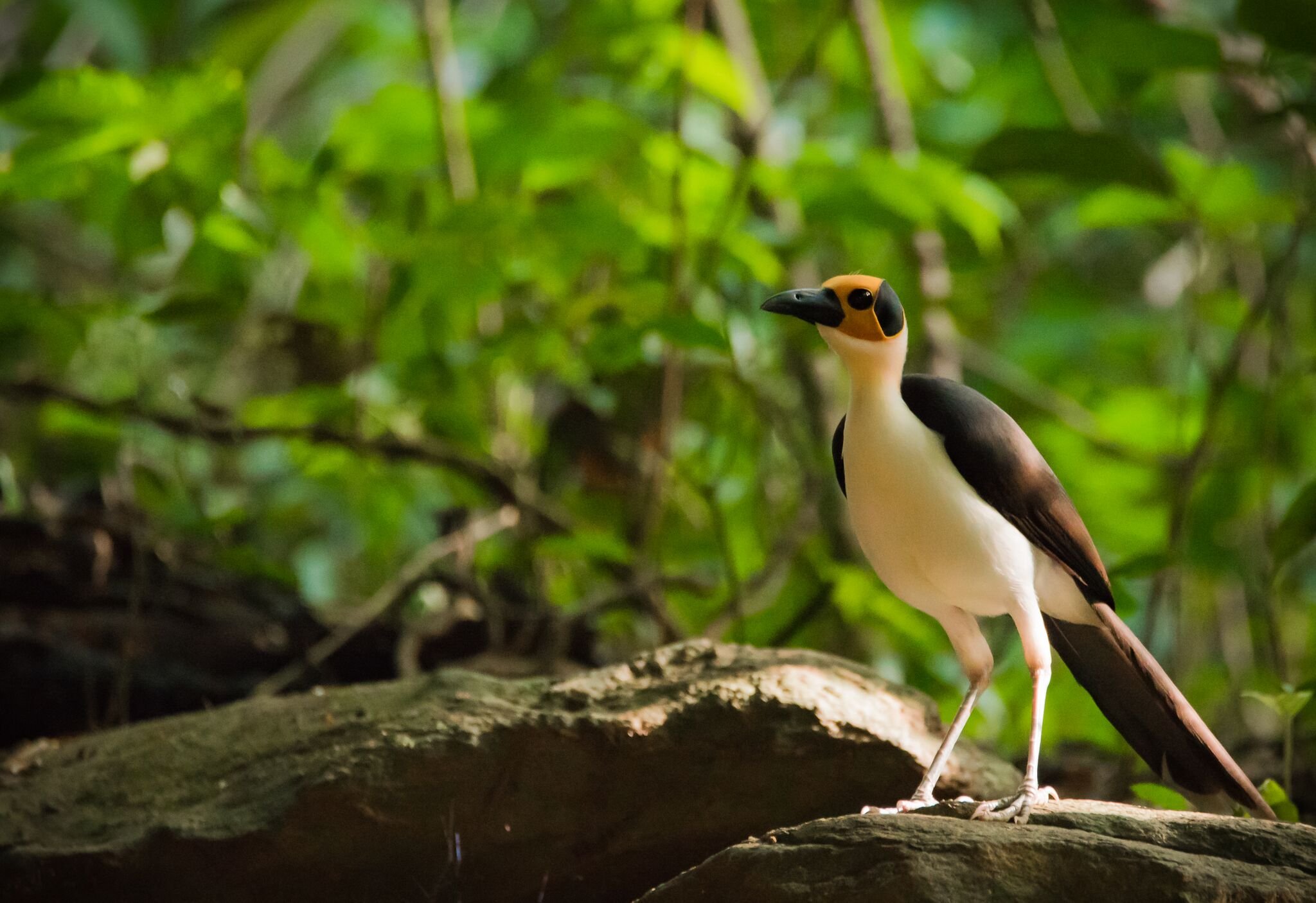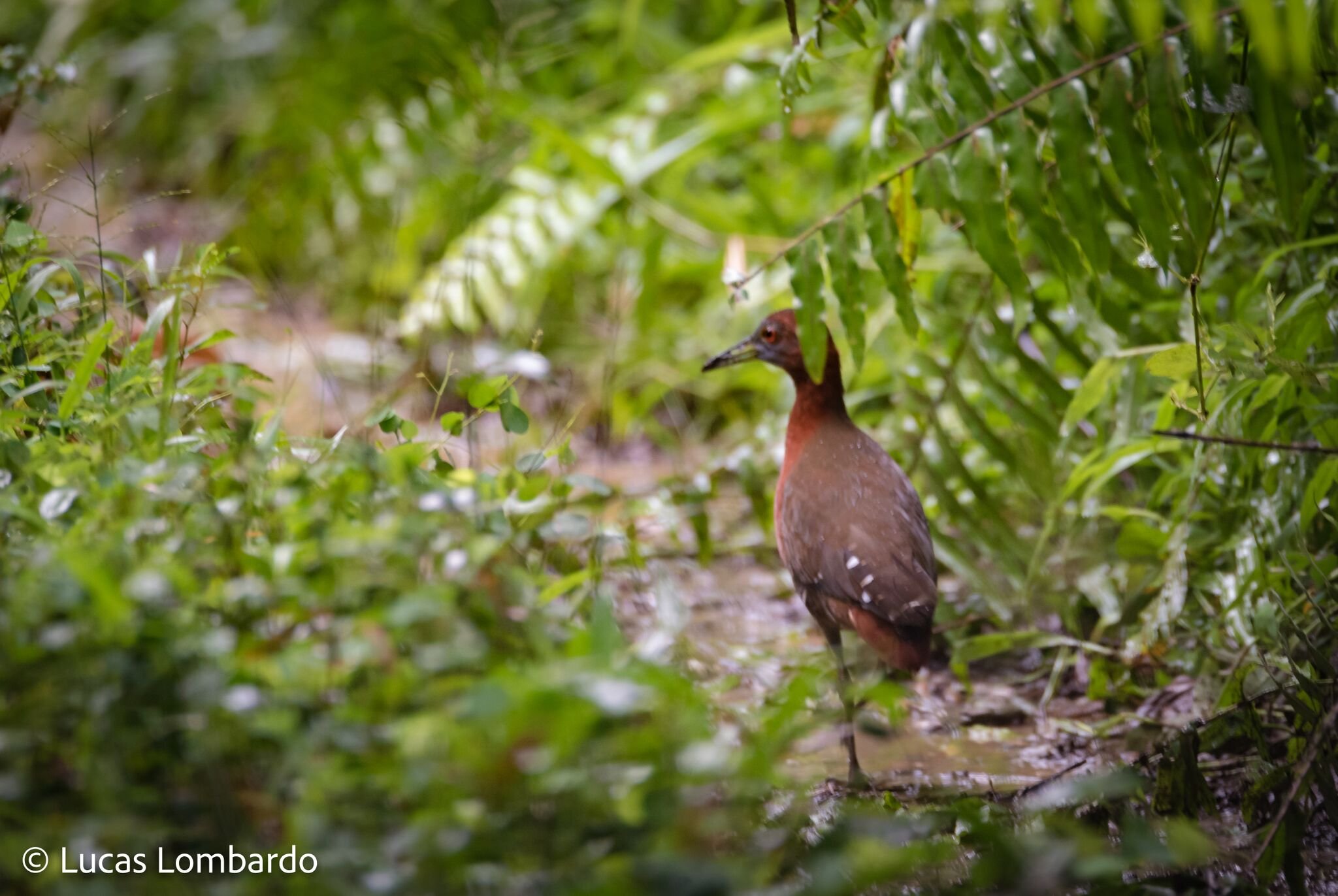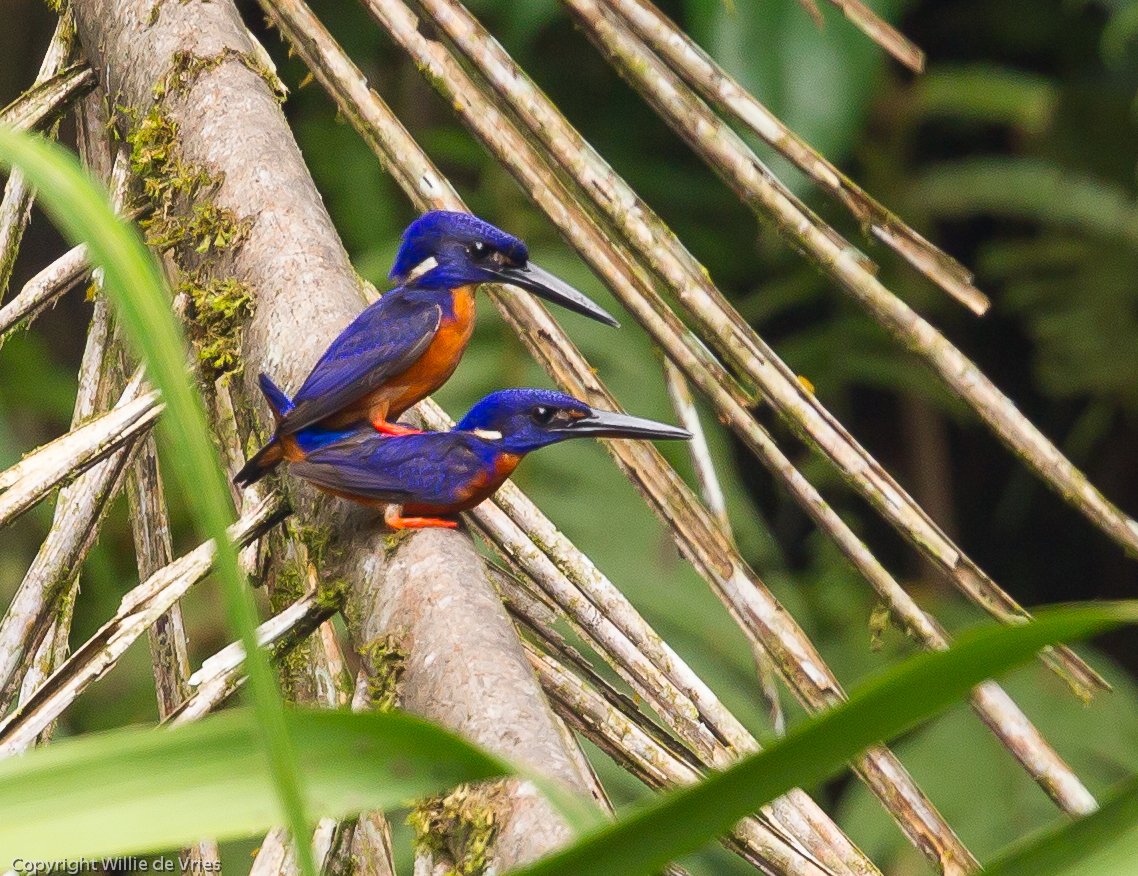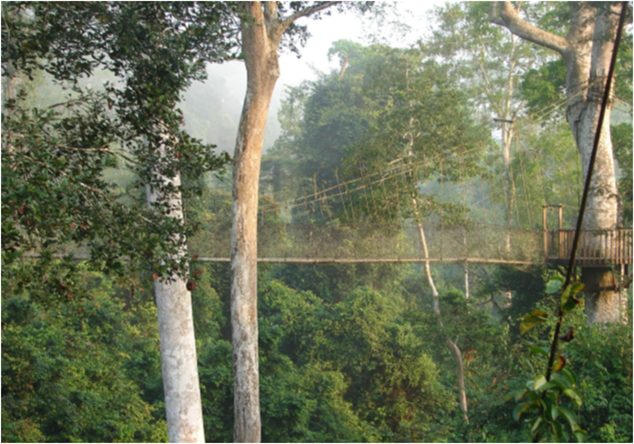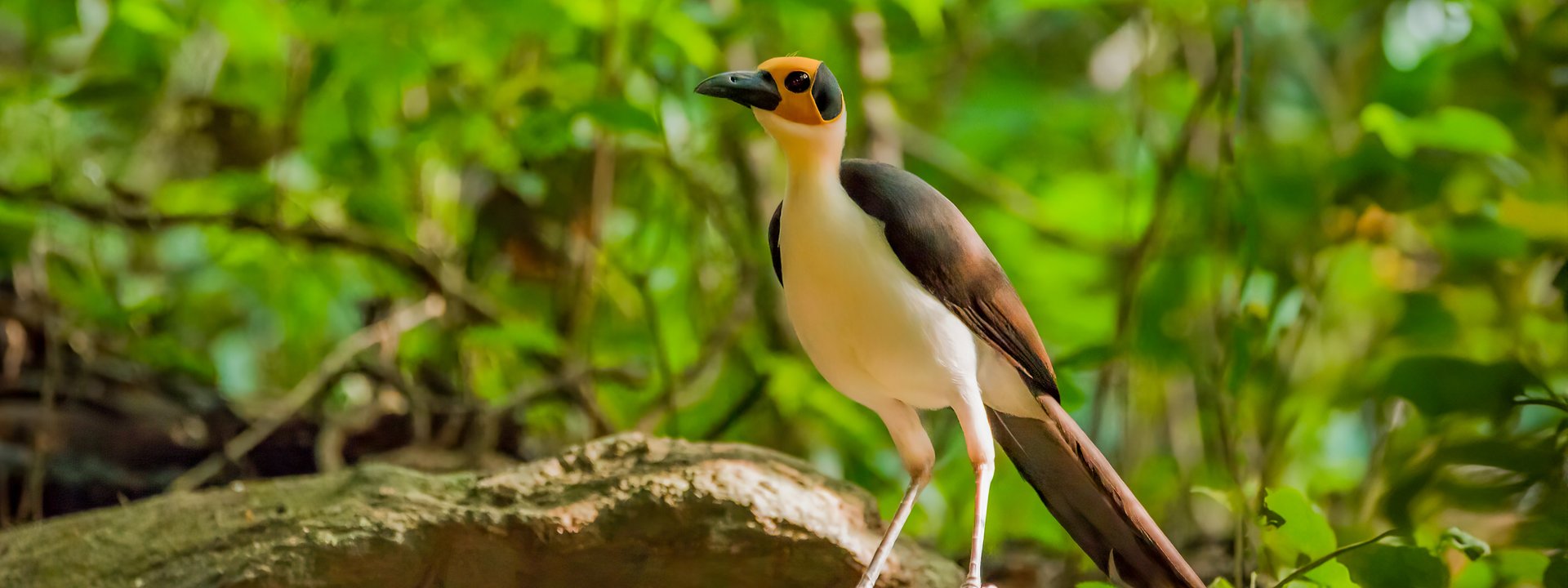Ghana
Birding the rainforests of West Africa
An all new small group tour exploring the rich rainforests for the extraordinary Rockfowl (or Picathartes) and many more West African specialities
Limosa's new tour to Ghana provides the opportunity to see a spectacular range of species including many which are endemic to West Africa. Amongst those we hope to find is one of the region's most iconic birds, the extraordinary White-necked Rockfowl (or Yellow-headed Picathartes), however, there is plenty more to see in a country which offers some of the most diverse birding in West Africa.
For the majority of our holiday, we will concentrate on visiting forest reserves and National Parks with one of the many highlights likely to be at the Kakum National Park where there is a canopy walkway with seven interlinked platforms which reach 40 metres above the forest floor.
Another destination will be the Ankasa Reserve which is considered to be one of the most diverse rainforests in West Africa. Being Ghana’s only wet evergreen rainforest, this is home to a number of Upper Guinea endemics and those we will look for include Yellow-bearded Greenbul, Rufous-winged Illadopsis and Green-tailed Bristlebill.
Moving on to the Abrafo Forest, we will visit a reliable site for White-necked Rockfowl and can expect some fantastic views of this prehistoric-looking bird. With chances for two species of pangolins and a whole suite of other birds, this location is likely to be another highlight of our holiday.
We will then continue our exploration of Ghana's rainforests with a visit to the Bobiri Sanctuary where we hope to find more specialities with the possibilities including Red-billed Dwarf Hornbill, Black-throated Coucal, Blue-headed Crested Flycatcher and Yellow-footed Honeyguide plus more widespread species such as the gorgeous Narina Trogon.
Our holiday will then conclude in the highland rainforests of the Atewa Mountain Range where new species could include Purple-throated Cuckooshrike, Blue-moustached Bee-eater, West African Batis, Chocolate-backed Kingfisher, Congo Serpent Eagle, Crested Malimbe, Forest Robin, Yellow-bearded Greenbul, Many-coloured Bushshrike and Western Nicator.
Led by Limosa's Frank Lambert and accompanied by an expert Ghanese birding guide, our new holiday offers a fantastic opportunity to explore the bird-rich forests of West Africa.
Tour Dates & Prices
Fri 10th January 2025
Fri 24th January 2025
- Available
Tour Cost: 15 Days from £4495 excluding flights
What's Included?
- Limosa Tour Leader
- Expert English-speaking Ghanaian bird guide
- 13 nights accommodation in comfortable hotels and lodges
- All main meals with drinking water provided during the day
- Surface transportation by minibus or other suitable vehicles
- All excursions, entry fees and permits
- Limosa checklist of mammals and birds
Cost Excludes
International flights, visa fees, insurance, drinks, airport meals/snacks and other items of a personal nature.
Notes
The Land Only Tour Cost is the amount you will pay Limosa.
Despite the end of pandemic restrictions, we have taken the decision to continue to price our holidays as excluding international flights.
To keep the process as simple as possible, we are working very closely with a dedicated agent at Travel Counsellors, Sacha Barbato, who is essentially now our “in house” flight consultant.
Sacha is a highly experienced independent ATOL bonded travel agent, and his contact details are as follows: sacha.barbato@travelcounsellors.com and 01603 360099
He will be able to advise you which flights we are recommending for each holiday and will be able to book these for you.
This will also sometimes give you the option to travel from a regional airport if you prefer.
Tour Highlights
- Superb introduction to the rich birdlife of West Africa
- Explore National Parks, forest reserves and open savannah habitats
- Visit the world famous canopy walkway at Kakum National Park with seven interlinked platforms which reach 40 metres above the forest floor
- Look for an exciting range of West African specialities Congo Serpent Eagle, Long-tailed Hawk, Nkulengu Rail, Fraser’s and Akun Eagle Owl; Rosy, Black and Blue-moustached Bee-eaters, Chocolate-backed Kingfisher and many others
- Search for Upper Guinea endemics including the extraordinary White-necked Rockfowl (or Yellow-headed Picathartes), the elusive White-breasted Guineafowl, Western Wattled Cuckooshrike, Yellow-bearded Greenbul, Rufous-winged Illadopsis and Green-tailed Bristlebill
- Chances for some great mammals including the possibility of two species of pangolin and up to 8 species of primate.
- Expertly led by Frank Lambert and a local Ghanaian bird guide
Outline Itinerary
Depart UK for Accra
Shai Hills Reserve, Sakamona Lagoon and Kakum National Park
Kakum National Park
Antwikwaa and Kakum National Park
Kakum Forest and Ankasa Reserve
Ankasa Reserve
Ankasa Reserve and Brenu Akyinim
Abrafo Forest
Bonkro Forest and Kwabena Sam Forest
Bonkro Forest and Bobiri Butterfly Sanctuary
Bobiri Butterfly Sanctuary and Atewa Range
Atewa Range
Atewa Range and depart Accra
Arrive UK
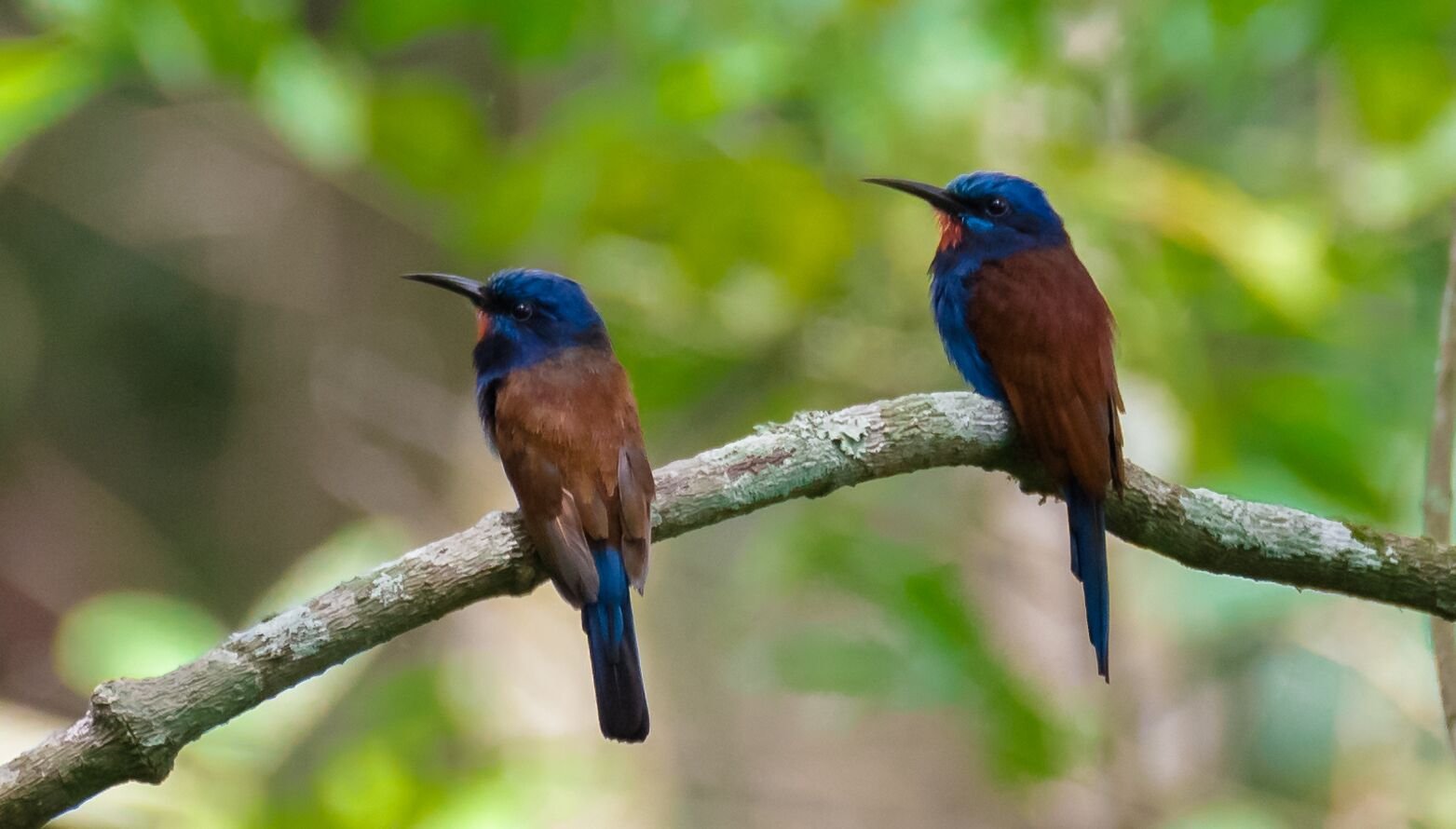
Ghana offers a superb introduction to the amazing avifauna of West Africa and our carefully planned itinerary visits many of the key areas giving the opportunity to see a spectacular range of species including one of the region's most iconic birds, the White-necked Rockfowl (or Yellow-headed Picathartes).
Starting on the coast not far from the capital, Accra, we will begin our holiday by exploring the open grassland savannahs of the Shai Hills Reserve, and the Sakamona Lagoon, for our first African specialities which could include Senegal Thick-knee, African Pygmy Kingfisher, Senegal Parrot, Senegal Batis, Red-shouldered Cuckooshrike, Violet Turaco, Blue-bellied Roller, Swallow-tailed Bee-eater and Snowy-crowned Robin-Chat.
Heading inland, we will then spend two days in the Kakum National Park where a canopy walkway offers an incredible opportunity to look for birds and other wildlife 40 metres above the forest floor. With seven interlinked platforms, the walkway provides a completely different perspective on the forest and by birding from this and the extensive network of trails within and around the park, we can expect to find a wide range of species which are restricted to the forests of West Africa with Little Green Woodpecker, Chestnut-capped Flycatcher, Yellow-casqued Hornbill, Blue Cuckooshrike, Red-rumped Tinkerbird and Buff-throated Sunbird amongst the possibilities.
Our next destination will be Ankasa Reserve, a protected area which is considered the most biologically diverse rainforest in Ghana and one of the most diverse in West Africa. Being Ghana’s only wet evergreen rainforest, a number of Upper Guinea endemics can be found here and those we will look for include Yellow-bearded Greenbul, Rufous-winged Illadopsis and Green-tailed Bristlebill. The poorly-known Nkulengu Rail is also present, as well as Forest Robin, White-tailed Ant Thrush, White-tailed Alethe, White-throated Bee-eater, Blue-headed Wood Dove, Western Bronze-naped Pigeon, Yellow-billed Turaco, Grey-headed Bristlebill, Tiny Sunbird and Red-fronted Antpecker.
Moving on to the Abrafo Forest, our next major target is the prehistoric-looking White-necked Rockfowl and we plan to visit an area where these extraordinary birds nest. There is an excellent chance of some fantastic views as the birds forage for food or possibly even bring this in for their young and this encounter is likely to be one of the highlights of our tour.
The rarely seen but highly colourful Western Wattled (Ghana) Cuckooshrike is also present in these forests and if we are fortunate, we could find this species along with a pangolin, as this location is the best place on our itinerary for both Long-tailed and White-bellied (Tree) Pangolins.
We will continue our exploration of the Upper Guinea rainforests with a visit to the Bobiri Butterfly Sanctuary where we hope to find more specialities with the possibilities including Tit Hylia, Red-billed Dwarf Hornbill, Black-throated Coucal, Blue-headed Crested Flycatcher and Yellow-footed Honeyguide, as well as somewhat more widespread species such as the gorgeous Narina Trogon.
Our trip will then conclude with a visit to the highland rainforests of the Atewa Mountain Range where new species could include Purple-throated Cuckooshrike, Blue-moustached Bee-eater, West African Batis, Chocolate-backed Kingfisher, Congo Serpent Eagle, Red-rumped Tinkerbird, Little Green Sunbird, Red-tailed Bristlebill, Crested Malimbe, Forest Robin, Yellow-bearded Greenbul, Many-coloured Bushshrike and Western Nicator.
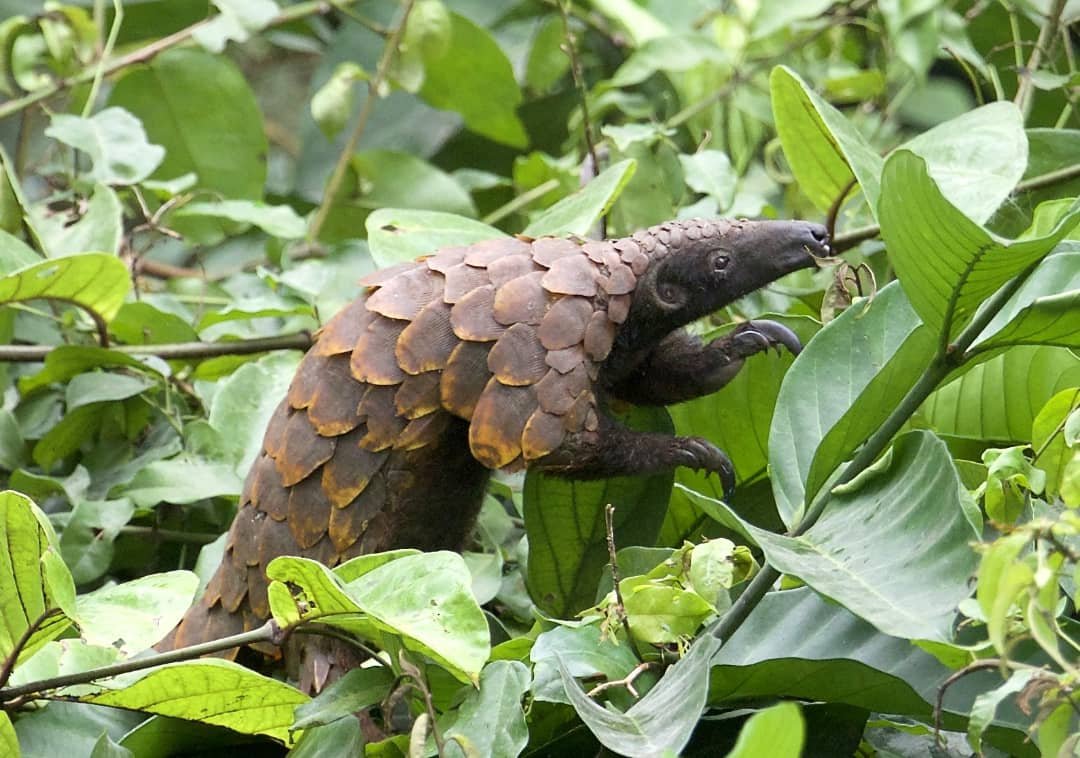
Day 1
DEPART UK FOR ACCRA
Our holiday starts with a flight to Accra, the capital of Ghana, where we will meet our local bird guide and driver and then make the short transfer to our hotel near the Shai Hills Reserve for an overnight stay. Night Tema
Day 2
SHAI HILLS RESERVE, SAKAMONA LAGOON AND KAKUM NATIONAL PARK
We will begin our birding in Ghana by heading to the open grassland savannahs of Shai Hills Reserve where we can expect to see a good selection of species which could include Northern Crombec, Yellow-fronted Tinkerbird, Snowy-crowned Robin-Chat, African Pygmy Kingfisher, Cardinal Woodpecker, Vieillot’s and Double-toothed Barbets, Rock Martin, Red-shouldered Cuckooshrike, Violet Turaco, Senegal Parrot, Senegal Batis, Blue-bellied Roller, Swallow-tailed Bee-eater, Oriole Warbler, Brown Babbler, Copper and Splendid Sunbirds, White-crested Helmetshrike, Red-necked and Lizard Buzzards, Lanner Falcon, Green Woodhoopoe and Stone Partridge.
We will then transfer to the Sakamona Lagoon where, depending on the water level, there is likely to be an abundance of birds. Whilst there should be plenty of familiar wintering species such as Black-tailed Godwit, Whimbrel, Common Greenshank and Spotted Redshank, we will concentrate on looking for less familar birds such as Spur-winged Plover, Senegal Thick-knee, Long-tailed Cormorant, Striated and Black Herons and Yellow-billed Egret, a recent split from Intermediate and Plumed Egrets.
We will then set off for Kakum National Park aiming to arrive at our accommodation which is near the park entrance in the late afternoon/early evening. Night Jukwa
Day 3
KAKUM NATIONAL PARK
After an early breakfast, we will head for the world-famous canopy walkway in Kakum National Park which has seven interlinked platforms. The park is only about 15-minute minute drive from our lodge, and we plan to arrive for first light to allow us to spend what is generally the best part of the day birding 40 metres above the forest floor.
There are a wide range of species to look for with plenty which are restricted to the forests of West Africa. Those we could see include Little Green Woodpecker, Violet-backed Hyliota, Chestnut-capped Flycatcher, Sharpe's Apalis, Brown-cheeked and Yellow-casqued Hornbills, Blue Cuckooshrike, Red-rumped and Speckled Tinkerbirds, Buff-throated Sunbird and Copper-tailed Starling.
Other possibilities include Red-fronted and African Grey Parrots, Yellow-billed Turaco, Rosy Bee-eater, Blue-throated Roller, Blue Malkoha, Red-headed and Crested Malimbes, Grey-crowned Nigrita, Rufous-crowned Eremomela, Western and Black-winged Orioles, Splendid and Chestnut-winged Starlings, Preuss's and Yellow-mantled Weavers, Green Hylia, Golden Greenbul, Yellow-throated Tinkerbird, Hairy-breasted and Naked-faced Barbets, Ussher's Flycatcher and Cassin's Honeybird.
A variety of raptors are also possible and those we could see include Congo Serpent-Eagle, Cassin's Hawk-Eagle, African Harrier-Hawk, Long-tailed Hawk and Red-necked Buzzard.
After what should be a fantastic morning watching from the walkway, we will return to our lodge for lunch and an opportunity to rest during the heat of the day. For those not wanting to take a siesta or explore the hotel grounds, there may be an optional excursion to Cape Coast Castle, before we return to the national park for the latter part of the afternoon.
As the temperature starts to cool and the bird activity increases, we may well head back to the walkway where new targets could include Palm Nut Vulture, Brown-cheeked, Black Dwarf and Yellow-casqued Hornbills as well as Great Blue Turaco and Yellow-footed Honeyguide. As the light starts to fade, we will hope to find our first nightbirds of the tour which could include Brown Nightjar and Fraser’s Eagle Owl. Two further nights Jukwa
Day 4
ANTWIKWAA AND KAKUM NATIONAL PARK
We plan to make another early start to visit the Antwikwaa section of Kakum National Park. A number of species we may not have seen are present in this area and these could include Ahanta Francolin, Ayre’s Hawk Eagle, White-spotted Flufftail, Piping Hornbill, Little, White-throated, Rosy and Black Bee-eaters, Blue-throated Roller, Red-rumped Tinkerbird, Cassin’s and Sabine’s Spinetails, Didric Cuckoo, Melancholy and Buff-spotted Woodpeckers, Vieillot’s Black and Black-necked Weavers, Western Nicator, Western Bluebill, Olive-bellied, Superb and Johanna’s Sunbirds, Copper-tailed and Violet-backed Starlings and Orange-cheeked Waxbill.
We also intend to visit a nearby river where we have chances for White-throated Blue Swallow, Preuss’s Cliff Swallow, Rock Pratincole, White-headed Lapwing, and, if we are fortunate, the tricky African Finfoot.
During the afternoon, we will concentrate on the many trails within and surrounding the park, which should prove to be very productive and new possibilities could include White-tailed Alethe, Red-tailed Bristlebill, Grey-headed Bristlebill, Black (Western) Dwarf Hornbill (likely to be split from Black (Eastern) Dwarf Hornbill), Red-billed Dwarf Hornbill, Olive Long-tailed Cuckoo, Forest Robin, Yellow-billed Turaco and Fire-bellied and Melancholy Woodpeckers.
We are likely to stay out until after dark to try for any owls and nightjars that we may still need before returning to our accommodation.
Day5
KAKUM FOREST AND ANKASA RESERVE
This morning we plan to concentrate on the trails, forest edge and scrub at Abrafo which is an area of forest habitat near to Kakum National Park. Potential new species here could include African Harrier Hawk, White-crested Hornbill, Pale Flycatcher, Brown-crowned Tchagra, Sooty Boubou, Puvel’s Illadopsis, Olive-green Camaroptera, Red-faced and Whistling Cisticolas, Lesser Striped Swallow, Fanti Saw-wing, Chestnut Wattle-eye, Naked-faced and Hairy-breasted Barbets; Frasers and Little Green Sunbirds, Blue Malkoha, Red-cheeked Wattle-eye, Swamp Palm Bulbul, Finsch’s Flycatcher Thrush and Spotted, Yellow-whiskered and Red-tailed Greenbuls. A number of sought after difficult species also occur including Long-tailed Hawk, Red-billed Helmetshrike, Rufous-sided Broadbill, Chocolate-backed Kingfisher, Olive Long-tailed Cuckoo, Congo Serpent Eagle, Red-billed and Black (Western) Dwarf Hornbills.
After lunch, we will set off westwards for the Ankasa Reserve, Ghana’s only wet evergreen rainforest. Protecting over 500 square kilometres of forest, this reserve is the most biologically diverse rainforest in Ghana and one of the most diverse in West Africa and is classified as an Important Bird Area ("IBA") by Birdlife International.
As well as an amazing bird list, Forest Elephant, Bongo, Chimpanzee and several species of Pangolin can all be found here, although we would count ourselves extremely fortunate to encounter any of these, although we can certainly expect to see a proportion of the 650 species of butterflies that have been identified within the reserve.
We plan to arrive in the late afternoon which should allow time to begin our exploration of the area which is likely to include an optional excursion after dark to look for Fraser's and Akun Eagle Owls. Night Ankasa
Days 6-7
ANKASA RESERVE
With plenty of specialities and regional endemics, we have two full days to explore this important location and on at least one morning, the day is likely to start before dawn in the hope of locating the poorly known Nkulengu Rail.
This is just one of many regional specialities which are possible and amongst our other targets will be a number of Upper Guinea endemics such as Yellow-bearded Greenbul, Rufous-winged Illadopsis and Green-tailed Bristlebill. Other species we hope to find include Ansorge’s, Icterine, Red-tailed and Western Bearded Greenbuls, Pale-breasted and Blackcap Illadopsis, Forest Robin, White-tailed Ant Thrush, White-tailed Alethe, Shinning Drongo, Cassin’s Flycatcher, Yellow-spotted Barbet, White-throated Bee-eater, Chestnut-breasted Negrita, Blue-headed Wood Dove, Western Bronze-naped Pigeon, Yellow-billed and Great Blue Turacos, Black-capped Apalis, Grey-headed Bristlebill, Tiny Sunbird and Red-fronted Antpecker.
During our stay, we plan to use 4x4 vehicles to explore along some of the rougher roads within the park. This will allow to reach some of the watering holes and visit sites deeper in the forest.
This will give us an opportunity to look for a range of species which are unlikely to be found closer to the forest edge including a number of tricky birds such as White-breasted Guineafowl, White-crested Tiger Heron, African Pitta, Grey-throated Rail, Dusky Long-tailed Cuckoo, Forest Scrub Robin, Blue-moustached Bee-eater and Red-chested Owlet.
Other possibilities include Hartlaub’s Duck, Dwarf Bittern and African Finfoot, as well as Shining Blue, White-bellied, Blue-breasted and African Dwarf Kingfishers. Crowned Eagle, Long-tailed Hawk and Congo Serpent Eagle can also be found here, and we will also hope to see Square-tailed and Fanti Saw-wings and Black-and-White Casqued, Black (Western) Dwarf and Piping Hornbills. Two further nights Ankasa
Day 8
ANKASA RESERVE AND BRENU AKYINIM
We will have a final morning at Ankasa and there should be an opportunity to explore some different areas or look for species we have not yet seen before we set off for Brenu Akyinim. As we travel, there are chances for a number of birds we may not have seen so far including African Pygmy Goose, Reichenbach’s, Carmelite and Brown Sunbirds, White-browed Forest Flycatcher and Orange Weaver.
The coastal savannah plains around Brenu Akyinim give us further opportunities to look for new species which could include Marsh Tchagra, Compact Weaver, Oriole Warbler, Red-headed Quelea and Black-rumped Waxbill and if we are fortunate, African Wattled Lapwing, Yellow-winged Pytillia and Wilson's Indigobird. Night Jukwa
Day 9
ABRAFO FOREST
We will depart Jukwa after breakfast for a remote destination in the Ashanti Region of Ghana where our ground agents assist the community with the proceeds from the accommodation, restaurant and forest entrance fees going into a village fund. The goal is to have a sustainable eco-tourism project with employment for the local people including forest rangers to prevent illegal hunting and logging.
Our main reason for coming is to visit a nesting site for the extraordinary White-necked Rockfowl (or Yellow-headed Picathartes). There are believed to be twelve nesting areas within the Abrafo Forest Reserve and the one we are likely to visit is about a 45-60 minute walk each way.
There is an overhanging rock face and small cave where these extraordinary prehistoric looking birds nest and we can expect to have some fantastic views as they forage snails, frogs and insects for their young.
As we return along the trail to our accommodation, the species we could find include Long-tailed Hawk, White-crested Hornbill, Grey-headed Bristlebill, Rufous-sided Broadbill, Thick-billed Cuckoo, Forest Woodhoopoe, Black and White Shrike Flycatcher and Grey-throated Tit Flycatcher. Night Bonkro
Day 10
BONKRO FOREST AND KWABENA SAM FOREST
As our accommodation is so close to the forest, we can have a slightly more relaxed breakfast before beginning our exploration of the nearby trails. This area can be highly productive and the birds we could find include Congo Serpent Eagle, Black (Western) Dwarf Hornbill, Red-tailed Bristlebill, Fire-bellied Woodpecker, Yellow-throated Cuckoo, Blue Cuckooshrike and Sharpe’s Apalis.
The rarely seen Western Wattled (Ghana) Cuckooshrike is also present in these forests and we will hope to find this colourful species along with a pangolin, as this reserve is the best place on our itinerary for both Long-tailed and Tree Pangolins.
After resting up during the heat of the day, we will head out again in the afternoon with Fraser’s Forest Flycatcher, Yellow-browed and Olive-green Camaropteras, Western Nicator, Puvel’s Illadopsis, Tit Hylia, Yellow-footed and Hairy-breasted Barbets, Green Crombec, Kemp’s Longbill, Black-cap Apalis, Blue-headed Crested Flycatcher, West African Wattle-eye, Red-cheeked Wattle Eye, Black-throated Coucal and Western Bronze-naped Pigeon amongst the species we hope to find.
Depending on what nocturnal species we still need, we may stay out after dark if there are any owls or nightjar species we haven't yet seen. Night Bonkro
Day 11
BONKRO FOREST AND BOBIRI FOREST
We will have a final morning birding in this special forest before returning to our accommodation to freshen up and enjoy lunch. We will then set off north towards Kumasi which is the capital of the Ashanti region where we will spend one night.
In the late afternoon, we plan to visit the Bobiri Forest which is home to the only butterfly sanctuary in West Africa. There are estimated to be almost 600 species in only 4.5 square kilometres of protected forest, which is more than have been recorded in Europe !!
Although we will (obviously) enjoy the butterflies, there are a number of birds to look for here and those we hope to see include Ahanta and Latham’s Forest Francolins and as darkness falls, we hope to see Brown and Long-tailed Nightjars, African Wood Owl, Fraser's and Akun Eagle Owls before returning to our hotel. Night Kumasi
Day 12
BOBIRI FOREST AND ATEWA RANGE
During the morning, we will continue our exploration of the Upper Guinea rainforests around Bobiri and hope to find many of the specialities that occur in this region with the possibilities including Tit and Green Hylias, Magpie Mannakin, Narina Trogon, Red-billed Dwarf and Black Dwarf Hornbills, African Grey and Brown-necked Parrots, Purple-throated Cuckooshrike, Black-throated Coucal, Golden-backed Weaver, African Piculet, Red-chested Owlet, Dusky Tit, Blue-headed Crested Flycatcher, Yellow-billed Barbet, Grey-headed and Red-tailed Bristlebills and the highly sought-after Yellow-footed Honeyguide.
We will then head south towards Atewa where we plan to explore farmland bush habitats where there are a new suite of species to look for including Black-necked, Maxwell's Black, Compact and Grosbeak Weavers, Whistling Cisticola, Black-crowned and Marsh Tchagras, Emerald, Klaas’s, Levaillant's and Yellow-throated Cuckoos, Red-bellied Paradise Flycatcher, Western Bluebill, Tessmann’s Flycatcher and if we are fortunate, both Baumann’s Olive Greenbul and Bat Hawk. Second night Kumasi
Day 13
ATEWA RANGE
The highland rainforests at Atewa are highly threated by a proposal for a bauxite mine but the area remains an important one for many species and we plan to spend the full day birding here.
We plan to take a packed lunch with us to maximise on the chances of finding our targets which include Purple-throated Cuckooshrike, Blue-moustached Bee-eater, West African Batis, Chocolate-backed Kingfisher, African Hobby, Congo Serpent Eagle, Red-rumped Tinkerbird, Little Green and Collared Sunbirds, African Goshawk, Red-tailed Bristlebill, Red-headed and Crested Malimbes, Forest Robin, Little, Little Grey, White-throated and Yellow-bearded Greenbuls, Many-coloured Bushshrike, Western Nicator, and Western Bronze-naped Pigeon. Night New Tafo
Day 14
ATEWA RANGE AND DEPART ACCRA
We will have a final morning exploring other locations within the Atewa Range and further species we could find include Red-cheeked Wattle-eye, Long-tailed Hawk, Yellow-rumped and Speckled Tinkerbirds, Buff-throated, Blue-throated Brown and Olive-bellied Sunbirds, Green-tailed Bristlebill, Icterine, Red-tailed, Western-bearded Greenbul and Brown Illadopsis.
A number of rarer birds can also be found here and we will hope to find Red-fronted Antpecker, Nimba Flycatcher, Crowned Eagle, Brown-chested Alethe, Forest Scrub Robin and Lowland Akalat before we reluctantly return to our hotel for lunch, freshen up and then depart for Accra and a late evening flight back to the UK.
Day 15
ARRIVE UK
We should arrive in the UK in the morning where our tour to Ghana concludes.
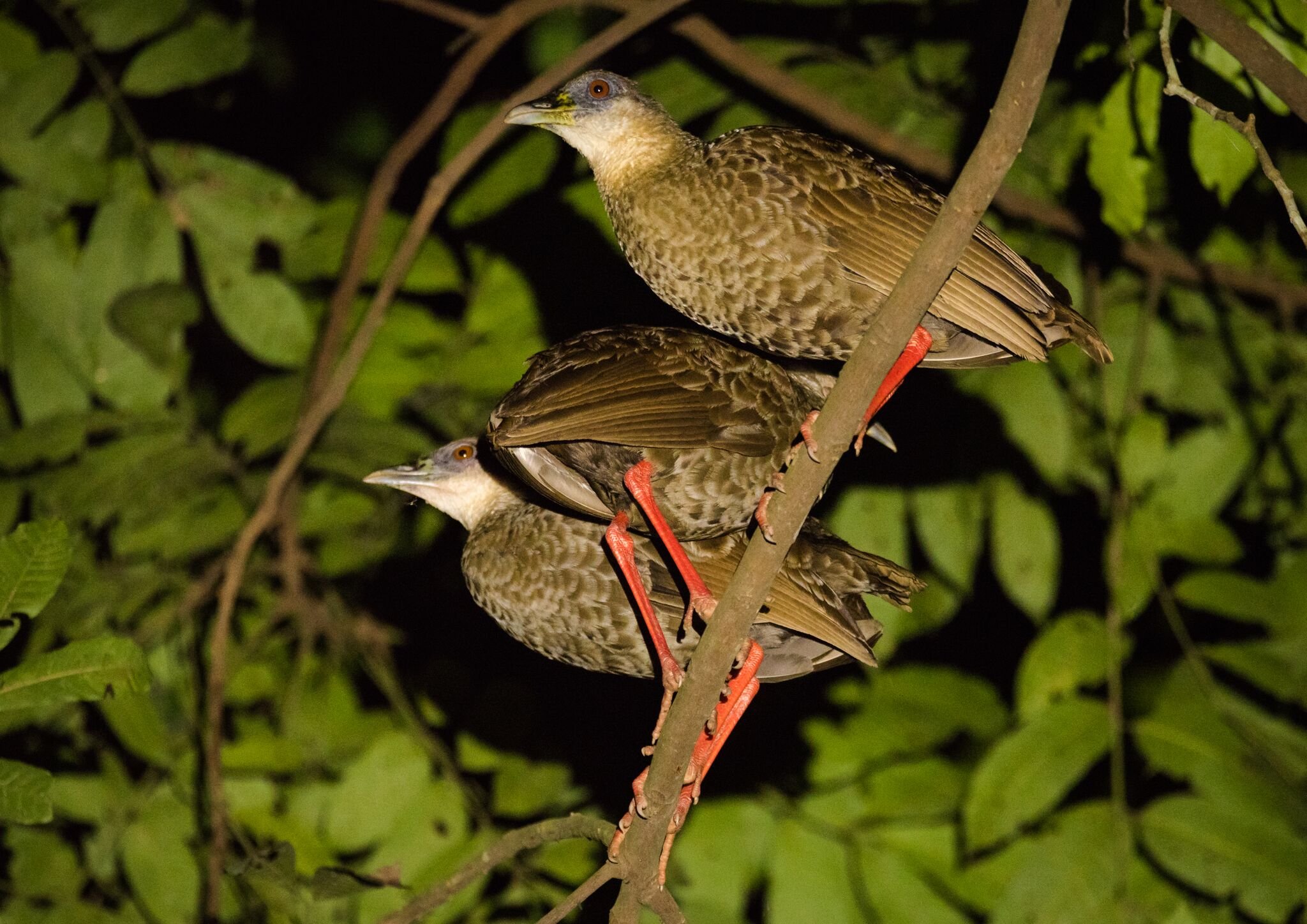
WHAT TO EXPECT
A fifteen day, small group birding tour to Ghana exploring National Parks, forest reserves and more open habitats for an exciting range of West African and Upper Guinea endemics.
Early starts are the norm for birding tours in tropical regions, where the daylight hours are relatively short (in Ghana at this time of year approximately 6.00am-6.30pm), and where bird activity peaks early and late but generally dies away completely during the hotter middle of the day.
It will be important to be in the field at dawn so we can hear the birds singing and calling as the day starts up as in some instances, this may be our only chance to discover if certain species are present or not, so we will naturally want to make the most of this opportunity.
We may be on our feet for several hours at a stretch watching for birds so some participants may find it helpful to bring a lightweight collapsible stool.
Our guides will be able to advise you locally about the day's events. If you wish to opt out of a particular session or walk, don’t be afraid to ask them.
Ghana has a tropical climate and it will be warm to hot throughout most of the tour. The late winter is an excellent time to visit, when the weather is mostly hot, sunny and dry. It will be humid at lower elevations and at this time of year, daily average temperatures around Accra are in the range of 23-31C (71-91F) but it may be a little cooler in the hills of the Atewa Range, but still humid.
Our tour is timed to run during Ghana's dry season, when rainfall is low but in the event it does happen to rain, this typically occurs as short-lived tropical downpours, so we recommend bringing a lightweight umbrella.
In common with all tropical regions, mosquitos are present throughout the year in Ghana, particularly around dawn and dusk in the coastal wetlands and mangroves, and along some low elevation forest trails so you are advised to check about malaria preventions.
Birds 300-400 species
Mammals 10-20 species
ACCOMMODATION
Twelve nights accommodation in good standard, mid-range hotels and lodges with all rooms having western-style private facilities and many of them having wifi. There will be no camping on this tour.
In some of the more remote locations the accommodation may be more basic but we always use the best option which is available.
MEALS
All main meals are included in the tour price (and with drinking water also provided), commencing with dinner on arrival in Ghana on Day 1 and concluding with lunch on Day 13.
Breakfast and dinners will usually be taken at the hotels and we may have packed lunches on some days (plus the odd packed breakfast) but other lunches may be taken at a convenient restaurant along the way.
WALKING
The walking effort is mostly easy. Away from the coast (where the terrain is flat), much of the birding on this tour is along roadsides, tracks and forest trails. Inevitably when walking in the mountains, there will be some steeper sections along the roads and tracks, although these are usually quite short and, wherever possible, we will aim to drive uphill and bird as we walk back down.
The longest walk will be in the mountains at Atewa where there may be the option to go upto 6kms in each direction, however, there will be the option to either make this a shorter walk for those who wish or to opt out entirely.
Comfortable, lightweight walking shoes or boots with stout soles and good grip are recommended.
GROUND TRANSPORT
By air-conditioned minibus.
FLIGHTS
We have taken the decision to continue to price our holidays as excluding international flights as we believe this gives our clients more flexibility and often makes the overall price cheaper.
To keep the process as simple as possible, we are working very closely with a dedicated agent at Travel Counsellors, Sacha Barbato, who is essentially now our “in house” flight consultant.
Sacha will be able to advise you which flights we are recommending for each holiday, and he will be able to book these for you.
This will also sometimes give you the option to travel from a regional airport if you prefer.
Tour Gallery
View a gallery of images for this tour below, click on an image to view as full size with caption
